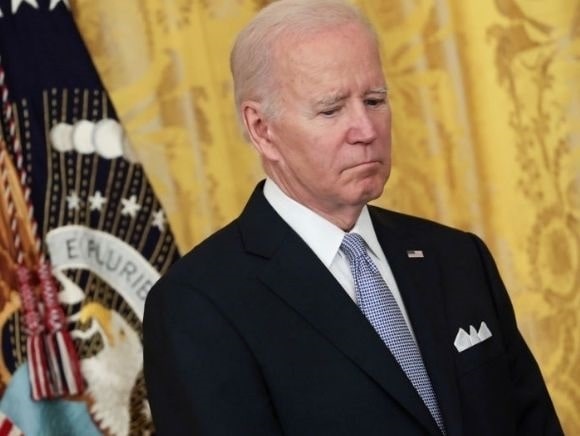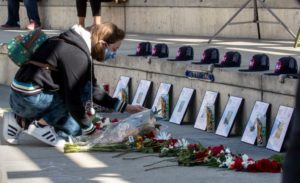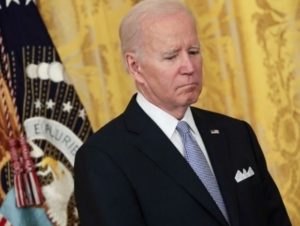
Joe Biden (Photo by Anna Moneymaker/Getty Images)
President Joe Biden addressed the nation Wednesday, May 25, to condemn the massacre in Uvalde, TX. Like any other tragic shooting, this proved a perfect opportunity to call for stricter gun control – and in the process, spew some more falsities presented as facts. No, it wasn’t deer in Kevlar this time, or how illegal it has always been to own a cannon. Instead, he used the school shooting as another chance to hype up a new federal assault weapons ban by boasting about the progress made by the last one. “When we passed the assault weapons ban, mass shootings went down. When the law expired, mass shootings tripled,” declared the commander-in-chief. History, however, disagrees.
Mass Shootings by the Year
 Two sources – Statista and Mother Jones – have independently tracked mass shootings based on media and government reports going back to 1982. Both are up to date and show the same data, which is based on the same definition of mass murder now used by the FBI: three victims killed, not including the killer, in one location or more than one in close proximity, which excludes serial and spree killings. Other sources, of course, have used other criteria, which is why media reports vary so widely. The definition of a mass shooting, as Liberty Nation reported back in March of 2021, is a bit of a moving goalpost.
Two sources – Statista and Mother Jones – have independently tracked mass shootings based on media and government reports going back to 1982. Both are up to date and show the same data, which is based on the same definition of mass murder now used by the FBI: three victims killed, not including the killer, in one location or more than one in close proximity, which excludes serial and spree killings. Other sources, of course, have used other criteria, which is why media reports vary so widely. The definition of a mass shooting, as Liberty Nation reported back in March of 2021, is a bit of a moving goalpost.
Prior to 2013, the FBI definition required four deaths, but using the new method, as followed by Statista and Mother Jones, there have been 128 mass shootings since the beginning of 1982. Before the ban, there were two years without mass shootings, five years with just one each, three in which there were two incidents, and then one year in which there were three and one in which there were four. The ban took effect in January of 1994 and ran through September 13, 2004. During that time, there was just one year without a mass shooting: 2002. There were seven years with just one each. There were two mass shootings in 1997, three in 1998, and five in 1999, right in the middle of the ban, bringing the total for the ban decade to 17, just one less than the 18 from the 12-year span before. So, no, mass shootings did not decrease with the 1994 assault weapons ban. They did, however, get worse as time went on.
There were no shootings in the remainder of 2004 after the ban expired, but 2005 saw two. There were three in 2006, 2008, and 2011; four in 2007 and 2009; five in 2013; and seven in 2012. Just one year – 2010 – in that decade saw a single mass shooting.

(Photo by Karl Mondon/MediaNews Group/The Mercury News via Getty Images)
There were four in 2014, seven in 2015, six in 2016, 11 in 2017, 12 in 2018, and 10 in 2019. With the pandemic and folks staying home, there were just two mass shootings in 2020, then back up to six in 2021. There have been three thus far in 2022, and there’s still half a year to go. So did mass shootings triple after the ban? If you squint hard enough and ignore a few years here and there, sure.
School Shootings – ‘Mass’ or Otherwise
The other big headline-grabbing trend related to this topic is school shootings – some of which qualify as mass shootings, though not all do. School shootings in America predate the United States. On July 26, 1764, four Lenape Native Americans entered a log schoolhouse in the Province of Pennsylvania and killed the schoolmaster and ten students. Of course, this only counts as a school shooting because the schoolmaster, Enoch Brown, was shot. The only other people present were the ten child victims, who were beaten to death, and one student who escaped. Still, history records the Enoch Brown Massacre as the first school shooting in America – 24 years before the Constitution took effect. A look at the numbers over the years shows a disturbing – and familiar – trend:
- 1840s: 1
- 1850s: 3
- 1860s: 5
- 1870s: 7
- 1880s: 10
- 1890s: 6
- 1900s: 13
- 1910s: 18
- 1920s: 10
- 1930s: 7 (5 of which were post-NFA.)
- 1940s: 8
- 1950s: 19
- 1960s: 21 (6 post-GCA.)
- 1970s: 40
- 1980s: 60
- 1990s: 92 (59 post-ban and Brady.)
- 2000s: 70 (32 before the ban expired.)
- 2010s: 230
- 2020: 17 (Lockdowns and school closings.)
- 2021: 33
- 2022: 19 (And we have about half a year to go.)
Barring a few decades here and there, school shootings – much like mass shootings – have become more frequent over time, cresting in 2019. Both data sets declined considerably for 2020, but that was the year of pandemic lockdowns and school closings. Then both then began to climb once again in 2021.
The Legacy of Gun Control

Joe Biden (Photo by Anna Moneymaker/Getty Images)
Another trend that has grown over time is the restriction of the right to keep and bear arms. And as we can see by looking at the numbers above, nothing – not the National Firearms Act of 1934, the Gun Control Act of 1968, or the 1994 Brady Act and Federal Assault Weapons Ban – seems to have made a dent. Neither school shootings or mass shootings in general declined when the ban took place, nor did either immediately spike once it expired. Once again, the facts prove President Biden to be incorrect.
And on a larger scale, these numbers show that no federal firearms restrictions have actually decreased the number of mass shootings or school shootings. If the regulations have had any effect at all on the murder rate, it must have been negative – as we see the numbers continue to climb year by year, decade by decade. Then there’s the fact, as famous gun researcher John Lott once pointed out, that 98% of all mass shootings since 1950 have taken place in gun-free zones. The policies President Biden and the Democrats push to cure gun violence simply don’t stop violent people from killing others – with or without firearms. They do, however, create target-rich environments in which these sick individuals can thrive and rob law-abiding Americans of the ability to defend themselves and others. That’s the true legacy of gun control.
Remember to check out the web’s best conservative news aggregator
Whatfinger.com — the #1 Alternative to the Drudge

